Minnesota
PRAIRIE ISLAND DAKOTA (SIOUX) RESERVATION |
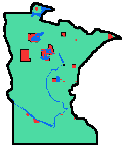 |
|---|---|
|
Federally recognized
Goodhue County, Minnesota |
Total area: 400 acres
|
|
Prairie Island is a Mdewakanton (Sacred Water, Spirit Lake) Dakota tribe. Their chiefs were among the signatories of the 1805 Zebulon Pike Treaty, that ceded land -- about 36,000,000 acres -- east of the Mississippi, and later almost all land except for 10 mile strips on each side of the Minnesota River (to the northwest) which were lost by the Traverse des Siouxtreaty of 1858. See Minnesota Treaties page for all relevant treaties. This loss, swindles by claimants against tribal annuities land payments, and refusal to issue rations led to the so-called Great Sioux Uprising of 1862. A few Mdewakantons remained in Minnesota after the mass hanging at Mankato and the great exiling to Nebraska and South Dakota. In 1899 the small reservation on a low-lying island on the banks of the Mississippi was established for the Prairie Island Dakota Community by act of Congress in 1889. Treasure Island -- beginnings of a website on Prairie Island's casino which graphically at this preliminary point looks as if it will be quite neat. As of Feb, 1997, nothing much there but a few pix, and mention of (now completed) hotel. The casino employs about 1500 people, including 486 tribal members. Tribal government employs about 100 members on a variety of service projects
Jerry Dearly (Oglala educator) recalls the summer of 1978 working with Amos at a Prairie Island culture camp he conducted: "I had the opportunity of looking for medicine at Prairie Island, with Amos Owen, traditionalist and sacred Pipe maker. After a scred Pipe ceremony at sunrise and a traditional Indian meal, we looked for a powerful healing pejuta [medicine]. This pejuta was utilized for all ailments of the Indian people long ago and is used by the traditional Indian people of today. It grows in the shape of a human body or parts of the human body. We also found pejuta ska ([qwhite medicine] a healing pejuta for stomach and simpka tawoyute, a pejuta for the throat and colds. We spent a lot of time finding these medicines, looking for the pejuta by shape, size color and location of the plants. "We hunted with thoughts of goodwill to help the sick who need this pejuta from Mother Earth. Tobacco was offered each time we took medicine, to express our thanks. I believe this experience was one of the survivla skills culturally and traditionally needed by our youth, who must learn from us who also learn from others as traditional teachings are handed down." Amos Owen was always willing to conduct ceremonies for people who were ill or needed spiritual help. With Dakota elder Martin High Bear, he sometimes travelled to nearby states to conduct ceremonies at the request of Indian people there, such as winter vision quests in the snow for young people. He maintained a sweat at Prairie Island for many years, which people from the nearby Twin Cities frequently traveled to. Attending these sweats was both inspiring and disconcerting. The small, humble, ancient lodge dome, with a nearby firepit to heat stones, faced off against the huge, bright-lit white containment dome of Northern States Power's double nuclear reactor generating plant -- the nuke -- just a few hundred yards away, across the coolant waters. The rest of this article discusses and links-to information about the NSP Prairie Island nuke, built in the early 1970's just a few hundred yards from this small reservation, and the current controversy about the storage of spent fuel rods (extremely radioactive for 24,000 years) in huge barrels, called dry casks, just 500 yards from the reservation Day Care center.
The spent (very radioactive) fuel rods of this nuke were stored for a while in a kind of big swimming pool inside the domes. By the early 1980's, this storage was no longer adequate. Northern States Power trucked away -- in secret trucks during the night -- some of the spent fuel rods. And they made plans to build a "temporary" storage facility, just 500 yeards from the reservation's Day Care Center. Using revenues from their successful casino, Prairie Island retained experts to study the situation, and eventually sued to halt this operation. They won, but the court simply said the state legislature must decide, not the Public Utilities Commission (which, like most, is in NSP's pocket). A local alliance grew from the issue: the American Indian Movement (AIM), environmental groups, concerned Minnesotans, and other environmentalists began to support the small tribe. There were demonstrations and lobbying -- the amateurs vs NSP, which spent more money lobbying this issue in a year than has ever been spent before at the rather sleepy Minnesota state legislature. Indigenous Environmental Network, an international group headquartered in Bemidji, MN, places these issues in context for indigenous peoples of the Western hemisphere. Click FIRE on the 4-directions wheel to see overviews of the nuclear issues as they affect tribes, and news about Native Nations which have adopted "'nuclear-free zones" policies. Prairie_Island: NSP text only simple statistics & timeline as supplied on one of the many, many NSP sites that provides their info -- or propaganda -- on this issue. Not surprisingly NSP stresses how safe its plant is. Actually, it has had several hot escapements which did not receive the national publicity of those occurring at one surrounded by non-Indian communities, Three Mile Island.
Prairie Island Press Release February 1, 1996 -- In recent legislative testimony, Minnesota Energy coalition supports the Prairie Island Dakota tribe. Agrees with tribe that if NSP is going to have its nuke and hazardous waste storage right there, they should pay the tribe to buy land, improve it to the equivalent of what's been built up oin the current reservation, and relocate. Prairie Island Bill-1996 HF 2784, SF 2495 Legislative watch on the latest Minnesota legislature bills re the Prairie Island nuke and radioactive storage. Status of Dry Cask Storage at Prairie Island according to how it was going in the MN legislature (nuclear watch newsletter) INSCDB: Maps: Location: 10179 -- government map and some info about the Prairie Island nuke and the location of the cask storage for the hot fuel rods. This is a database or several databases within frames (so I can't bookmark relevant pages; you have to do lookups yourself). The site is maintained by the International Nuclear Safety group, and contains info on other nukes world-wide. NSP'S Nuclear Blackmail of Praire Island -- Speakout on how the giant billion-dollar company is offering this little reservation a small amount of money for their lives and their children's futures, reprinted (by Midwest Treaty Network) from News from Indian Country, February, 1996
NATIVE-L (March 1994): Mescalero Sign Nuke Waste Deal (Take 2) -- this was the deal: In 1994, when local opposition mounted to the Prairie Island dry cask (big barrels) storage of hot waste, suddenly a couple tribal spokesmen Mescaleros showed up for heavily publicized press conferences and legislative testimony: Hey, it won't be permanent, cuz we'll take the stuff (later) on our rez in New Mexico. Guess who paid their plane fare? Yep, analysis showed NSP spent more on lobbying the dry cask business than has ever before been spent in drowsy Minnesota. But the Prairie Island coalition raised plane fare for a Mescalero woman who explained that despite various repressions and election frauds, the majority of the Mescalero tribe doesn't want its future spoiled by hot waste on their land. Testimony Re: Prairie Island nuke hot waste storage 2/6/96 -- NSP is supposed to find some other site sez the legislature. Part One: Staff Report to EQB On The Siting Of A Dry Cask Storage Facility -- Parts 2 and 3 of the Environmental Quality Board report are accessed from the end of part 1 Dry cask storage is these barrels. Gee whiz, NSP just can't seem to find any other sites for their huge barrels of hot waste guess the legislature will have to authorize them to build a lot more barr3els near Prairie Island. Prairie Island Coalition sues Minnesota Agencies, Oct. 1996, lawsuit filed. Flood 97 Situation Reports from Minnesota Department of Emergency Management. situation report for 4/9 says sandbagging volunteers requested for Redwing and the Prairie Island Indian community. Click Prairie Island above, for a picture of the radioactive barrels sitting on a loose concrete slab there, and the nuke. (posted 4/10/97, early am) | |
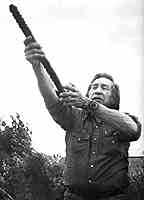 Prairie Island Mdewakanton elder Amos Owen conducts a Pipe ceremony on one of the small patches of land detached from the reservation village, in 1978. Amos was well-known for his efforts to preserve the Dakota language and culture. In the late 1970's and '80's, he conducted cultural and spiritual camps for Native youth of the nearby Twin Cities on this land.
Prairie Island Mdewakanton elder Amos Owen conducts a Pipe ceremony on one of the small patches of land detached from the reservation village, in 1978. Amos was well-known for his efforts to preserve the Dakota language and culture. In the late 1970's and '80's, he conducted cultural and spiritual camps for Native youth of the nearby Twin Cities on this land.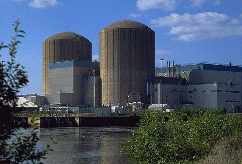 Prairie Island's main claim to fame is one no one would really like to have. Northern States Power, main electrical supplier for Minnesota and much of Wisconsin, in the early 1970's built a nuclear electrical generating plant just a few hundred yards from the small reservation separated by impoundment waters of the Mississippi Lock and Dam Number 2 nearby which are used for cooling the nuke. This photo shows the two large cylindrical containment domes. The Prairie Island plant contains two nukes (reactors).
Prairie Island's main claim to fame is one no one would really like to have. Northern States Power, main electrical supplier for Minnesota and much of Wisconsin, in the early 1970's built a nuclear electrical generating plant just a few hundred yards from the small reservation separated by impoundment waters of the Mississippi Lock and Dam Number 2 nearby which are used for cooling the nuke. This photo shows the two large cylindrical containment domes. The Prairie Island plant contains two nukes (reactors).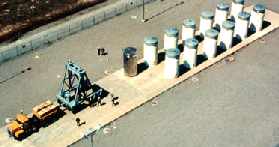
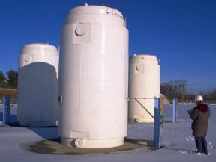 The concrete slab at Prairie Island has essentially no footing (foundation) and would immediately wash away in a flood, tipping the barrels -- and their contents, deadly for 24,000 years -- into the Mississippi river, and right down the center of the U.S. Presumably Virginia Power's slab and deadly barrels aren't on an island flood plain of a mighty river. Maybe the Virginia barrels of radioactive waste aren't within 500 yards of anyone's Day Care center, either. This photo of a couple of casks already emplaced at Prairie Island is by NSP. Site construction was going on even during the tribe's court injunction to halt it, but NSP built a big wall of dirt and fenced the site off to hide what was going on from photographers and press.
The concrete slab at Prairie Island has essentially no footing (foundation) and would immediately wash away in a flood, tipping the barrels -- and their contents, deadly for 24,000 years -- into the Mississippi river, and right down the center of the U.S. Presumably Virginia Power's slab and deadly barrels aren't on an island flood plain of a mighty river. Maybe the Virginia barrels of radioactive waste aren't within 500 yards of anyone's Day Care center, either. This photo of a couple of casks already emplaced at Prairie Island is by NSP. Site construction was going on even during the tribe's court injunction to halt it, but NSP built a big wall of dirt and fenced the site off to hide what was going on from photographers and press.